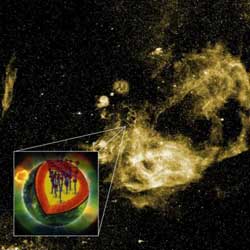Southampton researchers find a glitch' in pulsar 'glitch' theory

The background shows the Vela supernova remnant at optical wavelengths with location of the Vela pulsar indicated. The inset shows an artist's impression of the pulsar's interior, and the interaction between superfluid vortices and the nuclei that make up the star's crust.<br><br>Credit: Credit: CTIO/AURA/NSF<br>
A pulsar is a highly magnetised rotating neutron star formed from the remains of a supernova. It emits a rotating beam of electromagnetic radiation, which can be detected by powerful telescopes when it sweeps past the Earth, rather like observing the beam of a lighthouse from a ship at sea.
Pulsars rotate at extremely stable speeds, but occasionally they speed up in brief events described as 'glitches' or 'spin-ups'. The prevailing theory is that these events arise as a rapidly spinning superfluid within the star transfers rotational energy to the star's crust, the component that is tracked by observations. However, Southampton academics have used a mathematical model to disprove this.
Professor Nils Andersson explains: “Imagine the pulsar as a bowl of soup, with the bowl spinning at one speed and the soup spinning faster. Friction between the surface of the bowl and its contents, the soup, will cause the bowl to speed up. The more soup there is, the faster the bowl will be made to rotate.
“This analogy describes the concept behind the accepted theory of why pulsars suddenly increase speed or 'spin-up'. However, our research shows that these pulsar glitches are too large to be explained in this way. The amount of superfluid, or 'soup', available in the crust of a pulsar is too small to cause the kind of friction needed to create this effect.”
Professor Andersson and Dr Wynn Ho from the University of Southampton used their calculations, in conjunction with data from radio telescopes and recent results from nuclear physics theory, to challenge current thinking on this subject.
The Southampton researchers have written a paper detailing their theory, produced in collaboration with Kostas Glampedakis at the Universidad de Murcia, Spain and Cristobal Espinoza at the University of Manchester. It is published in Physical Review Letters, highlighted on http://physics.aps.org/synopsis-for/10.1103/PhysRevLett.109.241103.
Media Contact
More Information:
http://www.soton.ac.ukAll latest news from the category: Physics and Astronomy
This area deals with the fundamental laws and building blocks of nature and how they interact, the properties and the behavior of matter, and research into space and time and their structures.
innovations-report provides in-depth reports and articles on subjects such as astrophysics, laser technologies, nuclear, quantum, particle and solid-state physics, nanotechnologies, planetary research and findings (Mars, Venus) and developments related to the Hubble Telescope.
Newest articles

Sea slugs inspire highly stretchable biomedical sensor
USC Viterbi School of Engineering researcher Hangbo Zhao presents findings on highly stretchable and customizable microneedles for application in fields including neuroscience, tissue engineering, and wearable bioelectronics. The revolution in…

Twisting and binding matter waves with photons in a cavity
Precisely measuring the energy states of individual atoms has been a historical challenge for physicists due to atomic recoil. When an atom interacts with a photon, the atom “recoils” in…

Nanotubes, nanoparticles, and antibodies detect tiny amounts of fentanyl
New sensor is six orders of magnitude more sensitive than the next best thing. A research team at Pitt led by Alexander Star, a chemistry professor in the Kenneth P. Dietrich…





















